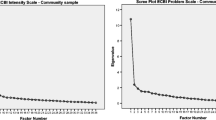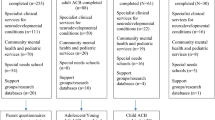Abstract
The Parental Concerns Questionnaire (PCQ) was designed as a parent-interview screening instrument for young children with developmental concerns at risk for potentially severe behavior problems (SBDs). Parents of 262 young children (4 to 48 months) answered to the 15 dichotomous PCQ items interviewed by trained staff. Cluster analysis for items revealed three item clusters, which we labeled Developmental/Social (8 items), Biomedical (3 items), and Behavior Problems (3 items). This paper discussed primarily the Behavior Problems cluster, with items referring to self-injurious, aggressive, and destructive behaviors. Parents’ concerns about behavior problems were high, with item-endorsements of the Behavior Problems cluster ranging from 41.8 % to 68.8 %. The Behavior Problems cluster was significantly correlated with all three subscales of the Behavior Problems Inventory (BPI-01), with select subscales of the Aberrant Behavior Checklist (ABC), and with the Repetitive Behavior Scale-Revised (RBS-R) providing some evidence for concurrent validity. Sensitivity and specificity data were computed for the three PCQ items as well as for the cluster score in comparison with the BPI-01, ABC, and RBS-R showing strong sensitivity. The PCQ Behavior Problems cluster is a useful screening checklist with high sensitivity for potential SBDs in young children at-risk for developmental delays.
Similar content being viewed by others
Notes
Two children who were performing SIB likely to cause tissue damage were removed from the study and put directly into an intensive behavior intervention program at CASP.
Dichotomized scores were obtained by transforming the continuous subscales scores to dichotomous scores to 0 (subscale score 0) and 1 (subscale score > 0).
also called “hit” or ”true positive” rates
also called “false positive” or “false alarm” rates
According to Tate (2013, August) AUC values indicate the accuracy of a test: .90–1.0 = excellent; 80–.90 = good; 70–.80 = fair; .60–.70 = poor; .50–.60 = fail. An area of 1 represents perfect accuracy and an area of .5 as represented by the diagonal line indicates zero accuracy.
References
Aman, M. G., & Singh, N. N. (1994). Aberrant behavior checklist-community. (Supplementary manual). East Aurora: Slosson Education Publications.
Aman, M. G., Singh, N. N., Stewart, A. W., & Field, C. J. (1985). The aberrant behavior checklist: a behavior rating scale for the assessment of treatment effects. American Journal of Mental Deficiency, 89, 485–491.
Bayley, N. (2006). Manual of the bayley scales of infant development (Thirdth ed.). San Antonio: NCS Pearson, Inc.
Berkson, G., & Tupa, M. (2000). Early development of stereotyped and self-injurious behaviors. Journal of Early Intervention, 23, 1–19.
Berkson, G., Tupa, M., & Sherman, L. (2001). Early development of stereotyped and self -injurious behaviors: I. Incidence. American Journal on Mental Retardation, 106, 539–547.
Bodfish, J. W., Symons, F. W., & Lewis, M. H. (1999). Repetitive behavior scale. Morganton: Western Carolina Center Research Reports.
Bodfish, J. W., Symons, F. W., Parker, D. E., & Lewis, M. H. (2000). Varieties of repetitive behavior in autism: Comparisons to mental retardation. Journal of Autism and Developmental Disorders, 30, 237–243.
Dawson, G. (1996). Brief report: neuropsychology of autism: a report on the state of the science. Journal of Autism and Developmental Disorders, 26, 179–184.
Dunlap, G., Strain, P. S., Fox, L., Carta, J. J., Conroy, M., Smith, B.J.,… Sowell, C. (2006). Prevention and intervention with young children’s challenging behavior: Perspectives regarding current knowledge. Behavior Disorders, 32, 29–45.
Einfeld, S. L., Tonge, B. J., & Clarke, K. S. (2013). Prevention and early intervention for behavior problems in children with developmental disabilities. Current Opinion in Psychiatry, 26(3), 263–268.
Fodstad, J. C., Rojahn, J., & Matson, J. L. (2012). The emergence of challenging behaviors in at-risk toddlers with and without autism spectrum disorder: a cross-sectional study. Journal of Developmental and Physical Disabilities, 24, 217–234.
Hess, C. R., & Landa, R. J. (2012). Predictive and concurrent validity of parent concern about young children at risk for autism. Journal of Autism and Developmental Disorders, 42, 575–584.
Marshburn, E. C., & Aman, M. G. (1992). Factor validity and norms for the Aberrant Behavior Checklist in a community sample of children with mental retardation. Journal of Autism and Developmental Disorders, 22, 357–373.
Matson, J. L., Boisjoli, J. A., Rojahn, J., & Hess, J. (2009). A factor analysis of challenging behaviors assessed with the Baby and Infant Screen for Children with aUtIsm Traits (BISCUIT-Part 3). Research in Autism Spectrum Disorders, 3, 714–722.
Mayo-Ortega, L., Oyama-Ganiko, R., LeBlanc, J., Schroeder, S.R., Brady, N., Butler, M.G.,… Marquis, J. (2012). Mass screening for severe problem behavior among infants and toddlers in Peru. Journal of Mental Health Research in Intellectual Disabilities, 5, 246–259.
Oyama-Ganiko, R., Mayo-Ortega, L., Schroeder, S.R., & LeBlanc, J.M. (in press). Early distance intervention and follow-up for families of young children at risk for developmental disability and severe behavior problems in Peru. Revista Educacao Especial Brazil.
Rojahn, J., Matson, J. L., Lott, D., Esbensen, A. J., & Smalls, Y. (2001). The behavior problem inventory: an instrument for the assessment of self-injury, stereotyped behavior, and aggression/destruction in individuals with developmental disabilities. Journal of Autism and Developmental Disorders, 31, 577–588.
Rojahn, J., Rowe, E.W, Sharber, A.C., Hastings, R. P., Matson, J.L., Didden, R.,… Dumont, E. L., M. (2012). Behavior Problems Inventory-Short from (BPI-S) for individuals with intellectual disabilities I: development and clinical norms. Journal of Intellectual Disability Research, 56, 527–545.
Rojahn, J., Schroeder, S. R., & Hoch, T. A. (2008). Self-injurious behavior in intellectual disabilities. New York: Elsevier.
Rojahn, J., Schroeder, S. R., Mayo-Ortega, L., Oyama-Ganiko, R., LeBlanc, J., Marquis, J., & Berke, E. (2013). Multi-method assessment of behavior problems among infants and toddlers at risk for neurodevelopmental disorders. Research in Developmental Disabilities, 34, 1804–1814.
Schroeder, S. R., & Courtemanche, A. B. (2012). Early prevention of severe behavior disorders: An integration. Journal of Mental Health Research in Intellectual Disabilities, 5, 203–214.
Schroeder, S.R., Marquis, J., Reese, R.M., Richman, D.M., Mayo-Ortega, L.,… Lawrence, L. (under review). Risk factors for self-injury, aggression, and stereotyped behavior among children at risk for intellectual and developmental disabilities.
Sheppard, A. G. (1996). The sequence of factor analysis and cluster analysis: Differences in segmentation and dimensionality through use of raw and factor scores. Tourism Analysis, 1, 49–57.
Tape, T. G. (2013). Interpreting Diagnostic Tests. University of Nebraska Medical Center. Retrieved from http://gim.unmc.edu/dxtests/Default.htm.
Author information
Authors and Affiliations
Corresponding author
Additional information
Disclaimer: Research reported in this publication was supported by the Fogarty International Center and the NICHD of the NIH under award number HD 060500. The content is solely the responsibility of the authors and does not represent the views of the National Institute of Health or the Center for Disease Control and Prevention.
Rights and permissions
About this article
Cite this article
Schroeder, S.R., Rojahn, J., An, X. et al. The Parental Concerns Questionnaire: A Brief Screening Instrument for Potentially Severe Behavior Problems in Infants and Toddlers At-Risk for Developmental Delays. J Dev Phys Disabil 26, 237–247 (2014). https://doi.org/10.1007/s10882-013-9359-8
Published:
Issue Date:
DOI: https://doi.org/10.1007/s10882-013-9359-8




